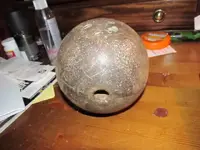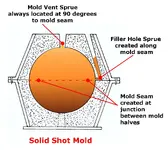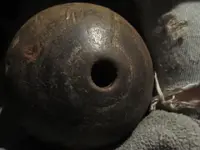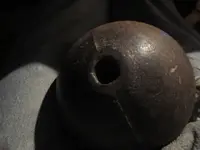You are using an out of date browser. It may not display this or other websites correctly.
You should upgrade or use an alternative browser.
You should upgrade or use an alternative browser.
20 pound ball.
- Thread starter Brian C.
- Start date
TheCannonballGuy
Gold Member
- Joined
- Feb 24, 2006
- Messages
- 6,607
- Reaction score
- 13,455
- Golden Thread
- 0
- Location
- Occupied CSA (Richmond VA)
- Detector(s) used
- White's 6000, Nautilus DMC-1, Minelab
- Primary Interest:
- Relic Hunting
You say the hole goes all the way through it... which enables me to reply with 100% certainty that it was never any kind of cannonball, nor Bar-Shot, etc, etc. I hope that's not too much of a disappointment. If you want to check my credentials for answering you with 100% certainty about it, see the "About me" section in my Profile here at TreasureNet.
Upvote
0
Brian C.
Bronze Member
- Joined
- Jan 14, 2011
- Messages
- 1,271
- Reaction score
- 1,332
- Golden Thread
- 0
- Detector(s) used
- Whites and Garrett. I use several machines, the ace 350 is a nice machine. I have a 5900, 6000, whites.
- Primary Interest:
- Relic Hunting
- #3
Thread Owner
Ok. So why are you so angry about my post. Later.
Upvote
0
TheCannonballGuy
Gold Member
- Joined
- Feb 24, 2006
- Messages
- 6,607
- Reaction score
- 13,455
- Golden Thread
- 0
- Location
- Occupied CSA (Richmond VA)
- Detector(s) used
- White's 6000, Nautilus DMC-1, Minelab
- Primary Interest:
- Relic Hunting
Angry? What? My reply to you expressed sympathy ("I hope that's not too much of a disappointment") along with the Factual answer to your question. (You asked, "if it were a cannon ball, it might have been a chain shot or a leg iron ball. Who knows for sure?")
Last edited:
Upvote
0
pa plateau hiker
Bronze Member
- Joined
- Jul 15, 2012
- Messages
- 1,111
- Reaction score
- 1,379
- Golden Thread
- 0
- Primary Interest:
- All Treasure Hunting
I see no anger in your reply Cannonballguy. You stated the facts. You have always impressed me with your knowledge.
Upvote
0
bman3725
Full Member
Gotta step up behind cannonballguy he his VERY knowledgeable in this area of history don't read any comment he makes the wrong way we are lucky to have someone with his expertise commenting and giving his educated insight just because he has a passion for it. I know one might think I know him on a personal level but I cannot assure u I do not. I have had several interactions here with him on forums and that's all but I've learned a lot from the guy and I have around 20 years experience in the field of question
As he stated my friend if there is a hole all the way through the middle of the item in question there's no way it was made for firing it out of a cannon. Think about what could happen with the hole gasses would be able to escape through it when fired which could be disastrous. It could be something industrial maybe?
Nice find just the same. Hope you find the answers to your questions my friend. Happy hunting
As he stated my friend if there is a hole all the way through the middle of the item in question there's no way it was made for firing it out of a cannon. Think about what could happen with the hole gasses would be able to escape through it when fired which could be disastrous. It could be something industrial maybe?
Nice find just the same. Hope you find the answers to your questions my friend. Happy hunting
Upvote
0
Gunrunner61
Silver Member
- Joined
- Jan 12, 2011
- Messages
- 2,963
- Reaction score
- 458
- Golden Thread
- 0
- Location
- Dalton,Ga.
- Detector(s) used
- Whites MXT, E Trac, Garrett Pro Pinpointer
- Primary Interest:
- All Treasure Hunting
Brian your Question makes no sense, What leads you to think CBG is mad from the answer that he gave you.
It was direct, to the point, And showed sympathy toward you hoping it was a cannonball. I'm sure that He could care less about your find, And was just trying to help you on the Id. Personally I hope that the folks of his caliber Do not get tired of all the S^%# when they post an answer for the lot of us who don't know half of what we dig, And then ( seem) to get angry with the answer we get. CannonballGuy I'd just like to thank you for the time you spend on this forum and the information you supply............jmho
It was direct, to the point, And showed sympathy toward you hoping it was a cannonball. I'm sure that He could care less about your find, And was just trying to help you on the Id. Personally I hope that the folks of his caliber Do not get tired of all the S^%# when they post an answer for the lot of us who don't know half of what we dig, And then ( seem) to get angry with the answer we get. CannonballGuy I'd just like to thank you for the time you spend on this forum and the information you supply............jmho
Upvote
0
Silver Searcher
Gold Member
The item looks to have a seem, as I know nothing of cannonballs, did they have a seem  I respect the fact it is not a cannonball, but was interested to know if they were cast whole, or made from two pieces. Or is the seem from the mold which made this.
I respect the fact it is not a cannonball, but was interested to know if they were cast whole, or made from two pieces. Or is the seem from the mold which made this.
SS
 I respect the fact it is not a cannonball, but was interested to know if they were cast whole, or made from two pieces. Or is the seem from the mold which made this.
I respect the fact it is not a cannonball, but was interested to know if they were cast whole, or made from two pieces. Or is the seem from the mold which made this.SS
Upvote
0
TheCannonballGuy
Gold Member
- Joined
- Feb 24, 2006
- Messages
- 6,607
- Reaction score
- 13,455
- Golden Thread
- 0
- Location
- Occupied CSA (Richmond VA)
- Detector(s) used
- White's 6000, Nautilus DMC-1, Minelab
- Primary Interest:
- Relic Hunting
Answering your (three) questions:
1- Is the seam from the mold which made this?
Yes.
2- As I know nothing of cannonballs, did they have a seam?
Some cannonballs do show a seam from the metalcasting mold, but most don't show a seam. The presence or absence of a casting-seam depends on the quality of the mold the cannonball was made in, and also on whether or not the manufacturer was being paid to remove all traces of a seam after the casting was completed. Colonial-era cannonballs often show a casting-seam, but by the time of the American Civil War, the quality of metalcasting molds had improved significantly.
I should mention here that Mill-Balls (a.k.a. rock-crusher balls from the Mining-&-Stonemilling industry) often -- but not always -- show a prominent moldseam. The reason is that on rock-crusher balls, the presence of a ridge-like seam doesn't matter ... but would cause problems with cannonballs, which MUST fit "smoothly" down into a cannon's barrel.
3- I was interested to know if they [cannonballs] were cast whole, or made from two pieces.
Cannonballs were never assembled from two separate pieces... they were always cast "whole." Here's a diagram showing the metalcasting mold arrangement for creating a Solid-Shot (not hollow shell) cannonball. The casting-mold itself did consist of two pieces, which were clamped together tightly for the casting proces. The mold's outer body is an iron container called the "flask." It contained tightly-compacted (or semi-concreted) sand, which is represented by tiny black dots in the diagram.
There is a very important reason why the mold had two holes. (One is called the filler-hole or "gate", and the other is called the mold's vent.) The reason has to do with worker safety during the metalcasting process. As you see in the diagram, the mold contains a large pocket of air, which is tightly enclosed. When the extremely hot (2,800+ degrees) molten iron is poured into mold, the air in the mold's "cavity" gets suddenly superheated and therefore expands very rapidly. if the only way for the expanding air to escape the airpocket is to rush back up through the mold's filler-hole, it blows molten iron droplets into the worker's face. So, a second hole was located at the very top of the mold, serving as a pressure-release "vent," so that the superheated air could escape harmlessly. Of course, the vent-hole had to be at the very top of the mold, or you wouldn't be able to completely fill the mold. Speaking of which... the vent had the additional benefit of allowing a worker to easily know when the mold had become completely filled. Instead of relying on waiting for the filler-hole to overflow, which would waste some molten metal, you look down the (shallow) vent-hole for the glowing molten iron reach the bottom of the hole.
If you want to learn more about that, and how to tell with certainty whether or not a metal ball is a cannonball, go here: SolidShotEssentialsMod
1- Is the seam from the mold which made this?
Yes.
2- As I know nothing of cannonballs, did they have a seam?
Some cannonballs do show a seam from the metalcasting mold, but most don't show a seam. The presence or absence of a casting-seam depends on the quality of the mold the cannonball was made in, and also on whether or not the manufacturer was being paid to remove all traces of a seam after the casting was completed. Colonial-era cannonballs often show a casting-seam, but by the time of the American Civil War, the quality of metalcasting molds had improved significantly.
I should mention here that Mill-Balls (a.k.a. rock-crusher balls from the Mining-&-Stonemilling industry) often -- but not always -- show a prominent moldseam. The reason is that on rock-crusher balls, the presence of a ridge-like seam doesn't matter ... but would cause problems with cannonballs, which MUST fit "smoothly" down into a cannon's barrel.
3- I was interested to know if they [cannonballs] were cast whole, or made from two pieces.
Cannonballs were never assembled from two separate pieces... they were always cast "whole." Here's a diagram showing the metalcasting mold arrangement for creating a Solid-Shot (not hollow shell) cannonball. The casting-mold itself did consist of two pieces, which were clamped together tightly for the casting proces. The mold's outer body is an iron container called the "flask." It contained tightly-compacted (or semi-concreted) sand, which is represented by tiny black dots in the diagram.
There is a very important reason why the mold had two holes. (One is called the filler-hole or "gate", and the other is called the mold's vent.) The reason has to do with worker safety during the metalcasting process. As you see in the diagram, the mold contains a large pocket of air, which is tightly enclosed. When the extremely hot (2,800+ degrees) molten iron is poured into mold, the air in the mold's "cavity" gets suddenly superheated and therefore expands very rapidly. if the only way for the expanding air to escape the airpocket is to rush back up through the mold's filler-hole, it blows molten iron droplets into the worker's face. So, a second hole was located at the very top of the mold, serving as a pressure-release "vent," so that the superheated air could escape harmlessly. Of course, the vent-hole had to be at the very top of the mold, or you wouldn't be able to completely fill the mold. Speaking of which... the vent had the additional benefit of allowing a worker to easily know when the mold had become completely filled. Instead of relying on waiting for the filler-hole to overflow, which would waste some molten metal, you look down the (shallow) vent-hole for the glowing molten iron reach the bottom of the hole.
If you want to learn more about that, and how to tell with certainty whether or not a metal ball is a cannonball, go here: SolidShotEssentialsMod
Attachments
Last edited:
Upvote
0
truckinbutch
Silver Member
- Joined
- Feb 15, 2008
- Messages
- 4,606
- Reaction score
- 1,036
- Golden Thread
- 0
- Location
- Morgantown,WV
- Detector(s) used
- Bounty Hunter Landstar
I think you owe CB Guy an apology . We are blessed to have a gentleman of his knowledge and experience willing to freely give his time here . I've seen him exhibit much more patience with posters here when they continue to argue with him because he explains to them that what they found is not what they wish it to be . He was trying to be nice to you .Well I may have taken it a little hard, any post i have seen on a cannon ball in question, you tend to tell the finder it is or never was a cannon ball. May be you know your stuff, but we were never there when the items were maid or the use they might have had, we can only guess, I like to tell people nice find, as far as the bull.>..stop.Nt.
Jim
Upvote
0
- Joined
- Jan 27, 2009
- Messages
- 18,875
- Reaction score
- 12,134
- Golden Thread
- 1
- Location
- South East Tennessee on Ga, Ala line
- 🥇 Banner finds
- 1
- Detector(s) used
- Tesoro Conquistador freq shift
Fisher F75
Garrett AT-Pro
Garet carrot
Neodymium magnets
5' Probe
- Primary Interest:
- All Treasure Hunting
I think it has been determined to not be a Cannon Ball and CBG he has been kind enough to identify many cannon balls on this forum Brian C.
You posted in the 'What is It" section and you do not need to argue with people kind enough to respond to your post. If you do not like the honest opinions and responses I will be happy to remove your post. The only reason I have not deleted this thread already is that others have provided useful information on what it is not.
You posted in the 'What is It" section and you do not need to argue with people kind enough to respond to your post. If you do not like the honest opinions and responses I will be happy to remove your post. The only reason I have not deleted this thread already is that others have provided useful information on what it is not.
Upvote
0
Brian C.
Bronze Member
- Joined
- Jan 14, 2011
- Messages
- 1,271
- Reaction score
- 1,332
- Golden Thread
- 0
- Detector(s) used
- Whites and Garrett. I use several machines, the ace 350 is a nice machine. I have a 5900, 6000, whites.
- Primary Interest:
- Relic Hunting
- #12
Thread Owner
My first message mentioned that I did not know what it was used for,( who really knows what it was used for), if you read it again I never said it was a cannon ball. I am glad CBG posted the detailed info on the shot size, this clears up that part. I am glad all you posters stick up for the people that have knowledge on different items, I would do the same. Later.
Upvote
0
- Joined
- Jan 27, 2009
- Messages
- 18,875
- Reaction score
- 12,134
- Golden Thread
- 1
- Location
- South East Tennessee on Ga, Ala line
- 🥇 Banner finds
- 1
- Detector(s) used
- Tesoro Conquistador freq shift
Fisher F75
Garrett AT-Pro
Garet carrot
Neodymium magnets
5' Probe
- Primary Interest:
- All Treasure Hunting
Thanks Brian Now maybe we can figure out" what it is" now that we know "what it is not" ? If it had a bar run thru it and rolled does it show use wear where it would be rolled? Ok I am tongue tied already 

Upvote
0
- Joined
- Jan 27, 2009
- Messages
- 18,875
- Reaction score
- 12,134
- Golden Thread
- 1
- Location
- South East Tennessee on Ga, Ala line
- 🥇 Banner finds
- 1
- Detector(s) used
- Tesoro Conquistador freq shift
Fisher F75
Garrett AT-Pro
Garet carrot
Neodymium magnets
5' Probe
- Primary Interest:
- All Treasure Hunting
Upvote
0
nhbenz
Gold Member
- Joined
- Dec 30, 2004
- Messages
- 6,821
- Reaction score
- 6,848
- Golden Thread
- 0
- Location
- Brentwood, NH
- Detector(s) used
- White's Classic SL
White's Surf P.I.
In the latest pictures I think I'm seeing wear marks (or rather "lack of wear" marks) from where it had a cup on each end, assuming those are opposite sides of the ball (its the type of thing where its hard to tell). I'd guess that would be indicative of it being held in place (on a bar) when in use, for what that's worth.
Does anyone know what the old time freight rollers looked like? Not that I would rule out a lifting weight.
Does anyone know what the old time freight rollers looked like? Not that I would rule out a lifting weight.
Upvote
0
Digs68
Sr. Member
- Joined
- Apr 14, 2012
- Messages
- 258
- Reaction score
- 79
- Golden Thread
- 0
- Location
- Mid-Missouri
- Detector(s) used
- Garrett AT Pro
Garrett Ace 350
Garrett Pro Pointer
- Primary Interest:
- All Treasure Hunting
From what I can see, one hole is rounded & the other is a bit squarish, which leads me to believe it had some sort of mushroomed or hammered end on that side. Sort of like a rivet would be pounded flat. I'm guessing a rod went through & was expanded on the other end to keep it in place. Other than the seam, there is a raised area on the side of the ball. You can see it on the left pic of the most recent posted close-up pics, going up over the top. There is also a raised rounded lip around the round hole in that same pic. I think it was something like a crane counterweight ball, possibly with a hook or something dangling from the other end. They are (or were) used to control the cable and hook so it wouldn't swing so much in the wind, I think. I'm just making a guess. But I think it was something similar to that. What do you think?
Upvote
0
Paleopilot
Hero Member
- Joined
- Dec 4, 2012
- Messages
- 566
- Reaction score
- 199
- Golden Thread
- 0
- Location
- South Dakota
- Primary Interest:
- All Treasure Hunting
Might be, what is known in the tower construction industry, as a "Headache Ball". They were used to counterweight the cable when stacking steel. They came in all sizes and configurations. More cable, more counterweight is needed. That one would be good for a small cable. The larger ones are around 250 pounds and are cylindrical in shape.
Upvote
0
digging440yrs
Gold Member
- Joined
- Dec 5, 2012
- Messages
- 5,946
- Reaction score
- 4,413
- Golden Thread
- 0
- Location
- UPSTATE NEW YORK
- Detector(s) used
- 1970 COMPASS-
WHITES SILVER EAGLE-
WHITES DFX, 4X6DD COIL, 6X8DD COIL, 950 COIL, 10X12SEF COIL-
GARRETT PRO POINTER AT, GARRETT AT PRO , MINELAB EXPLORER SE with 8.5x12.5 Cors coil
- Primary Interest:
- All Treasure Hunting
Balls like this were used in the early 1900s to roll on a floor to flaten and stretch new carpet and vinel flooring, this one looks to be a little larger then others ive seen, but may be in that catagory----

Upvote
0
Gunrunner61
Silver Member
- Joined
- Jan 12, 2011
- Messages
- 2,963
- Reaction score
- 458
- Golden Thread
- 0
- Location
- Dalton,Ga.
- Detector(s) used
- Whites MXT, E Trac, Garrett Pro Pinpointer
- Primary Interest:
- All Treasure Hunting
Just a thought here.....But boom trucks have an Added weight on the cable to help weigh the hook down on the
end of the cable, What size is the hole in it??...................HH
end of the cable, What size is the hole in it??...................HH
Upvote
0
Similar threads
- Replies
- 2
- Views
- 374
- Replies
- 5
- Views
- 463
Users who are viewing this thread
Total: 1 (members: 0, guests: 1)








